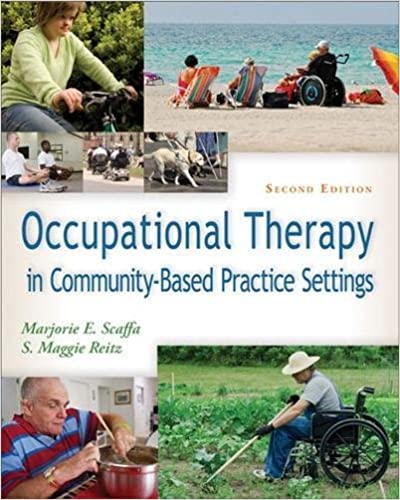
Occupational Therapy in Community-Based Practice Settings 2nd Edition by Marjorie Scaffa, Maggie Reitz
Edition 2ISBN: 978-0803625808
Occupational Therapy in Community-Based Practice Settings 2nd Edition by Marjorie Scaffa, Maggie Reitz
Edition 2ISBN: 978-0803625808 Exercise 1
Aretha
Aretha is on conditional release after being hospitalized in a maximum security hospital for 15 years and then transferred to a regional state psychiatric hospital for 10 years following a double homicide (i.e., murder of both her parents). It was hard to find a community placement because of the nature of her offense and difficulty convincing the judiciary that she was psychiatrically stable and thus less likely to be dangerous. After several successful trial visits, Aretha was accepted to a community placement. The agency and Aretha voluntarily agreed to visits from the occupational therapy consultant.
Several meetings were held with an agency case manager, Aretha, and the occupational therapist. The client discussed her anxiety about having lived in a hospital for "half her life" and worried about how to structure her time after attending the day program. Meetings focused around her goal of adjusting to roommates, completing house chores, getting to know the community, and managing with limited money.
Together, Aretha and the occupational therapist reviewed her conditional release requirements, developed simple goals, selected a bi-weekly time to meet, and discussed progress and next steps. Aretha had many artistic hobbies (e.g., painting and playing the piano). Suggestions were made as to where she could go in town to participate in like occupations. She was able to walk to and attend events provided by a free arts council. A suggestion was made to visit with the local peer-run support center. Further discussion revealed Aretha's hesitation in meeting peers and possibly discussing her past. The therapist commended her for "venturing out" and reassured her that there was no need to rush into what she felt was an "uncomfortable" place or situation.
Occupational therapy consultation revolved around providing the therapeutic relationship and transitional bridge between her hospitalization and the community. The client communicated her accomplishments, goals, and concerns to community residential staff. The client thanked the occupational therapist for meeting with her and stated she looked forward to their bi-weekly meetings.
Would you feel comfortable working with Aretha? Why or why not?
Aretha is on conditional release after being hospitalized in a maximum security hospital for 15 years and then transferred to a regional state psychiatric hospital for 10 years following a double homicide (i.e., murder of both her parents). It was hard to find a community placement because of the nature of her offense and difficulty convincing the judiciary that she was psychiatrically stable and thus less likely to be dangerous. After several successful trial visits, Aretha was accepted to a community placement. The agency and Aretha voluntarily agreed to visits from the occupational therapy consultant.
Several meetings were held with an agency case manager, Aretha, and the occupational therapist. The client discussed her anxiety about having lived in a hospital for "half her life" and worried about how to structure her time after attending the day program. Meetings focused around her goal of adjusting to roommates, completing house chores, getting to know the community, and managing with limited money.
Together, Aretha and the occupational therapist reviewed her conditional release requirements, developed simple goals, selected a bi-weekly time to meet, and discussed progress and next steps. Aretha had many artistic hobbies (e.g., painting and playing the piano). Suggestions were made as to where she could go in town to participate in like occupations. She was able to walk to and attend events provided by a free arts council. A suggestion was made to visit with the local peer-run support center. Further discussion revealed Aretha's hesitation in meeting peers and possibly discussing her past. The therapist commended her for "venturing out" and reassured her that there was no need to rush into what she felt was an "uncomfortable" place or situation.
Occupational therapy consultation revolved around providing the therapeutic relationship and transitional bridge between her hospitalization and the community. The client communicated her accomplishments, goals, and concerns to community residential staff. The client thanked the occupational therapist for meeting with her and stated she looked forward to their bi-weekly meetings.
Would you feel comfortable working with Aretha? Why or why not?
Explanation
Forensic mental health service:
A servi...
Occupational Therapy in Community-Based Practice Settings 2nd Edition by Marjorie Scaffa, Maggie Reitz
Why don’t you like this exercise?
Other Minimum 8 character and maximum 255 character
Character 255


